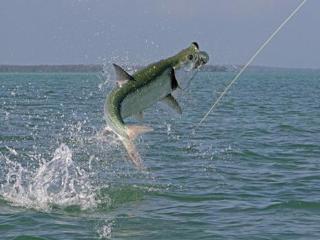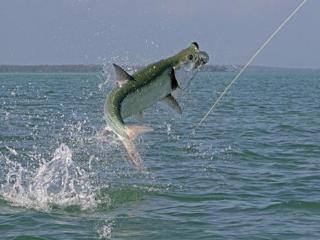 I’m happy to present part two of my three-part series on fly fishing’s coveted Grand Slam, a title earned by those dedicated anglers who are fortunate enough to catch three of the Caribbean’s most desired species—bonefish, tarpon, and permit—all in one day of fishing. Last time, we started things off by covering the sleek and powerful bonefish, a slender, shallow-water dwelling fish that, despite its modest size, is able to make your reel scream as it takes line on an impressive run. Now that you’re back for part two, I’ll give you some tips and knowledge about the awe-inspiring tarpon, arguably the most popular game fish in the Keys.
I’m happy to present part two of my three-part series on fly fishing’s coveted Grand Slam, a title earned by those dedicated anglers who are fortunate enough to catch three of the Caribbean’s most desired species—bonefish, tarpon, and permit—all in one day of fishing. Last time, we started things off by covering the sleek and powerful bonefish, a slender, shallow-water dwelling fish that, despite its modest size, is able to make your reel scream as it takes line on an impressive run. Now that you’re back for part two, I’ll give you some tips and knowledge about the awe-inspiring tarpon, arguably the most popular game fish in the Keys.
Commonly known as the “Silver King,” tarpon were one of the first species to be declared a game fish. Tarpon have earned their place as the most desired game fish, too, as they are known for energetic runs and several leaps while hooked. These actions, along with their awesome strength that interestingly contrasts their timid reluctance, make tarpon fishing a true challenge to any angler, seasoned or not.
Tarpon are typically found patrolling mangrove islands, rivers and canals, and isolated lakes. The larger fish are migratory, however, and arrive during late winter, staying through spring. These larger tarpon can be found on the deeper flats and channels, and around bridges. Though, the smaller fish are no pushovers themselves, and can make for a great fight on lighter tackle.
Tackle for tarpon will be, of course, larger than what you would use for bonefish. For a rod, you’ll want a 10-12 weight, and for leader, you’ll need to use sock tippets of 60-10 pounds, with 16-20 pound class tippet. The heavy-duty tackle is a definite must-have, as tarpon can reach sizes of 200 pounds! The flies you’ll want to try are the standard Keys flies, such as Cockroach and Apte-type patterns, Tarpon Bunnies in sizes 2/0 to 4/0, Surf Candies, Clousers, and Lefty’s Deceivers and Whistlers. As with most fish, use lighter colors during the day and once the sun begins to descend, switch to more natural and darker colors.
The true challenge when fishing for tarpon on the fly is staying calm throughout the fight. Many anglers are intimidated once they hook that first monster and it takes off on them, leaping over and over as it tries to free itself. Be patient and let the fish tire itself out, which may take a little time with a fish as strong as the tarpon, but I guarantee patience is a virtue that will pay for itself in dividends once you finally pull your prize to the boat. There’s nothing like a 200-pound tarpon caught on the fly, and if you’re lucky enough to experience such a dream on the water, I’m sure you’ll agree wholeheartedly!








